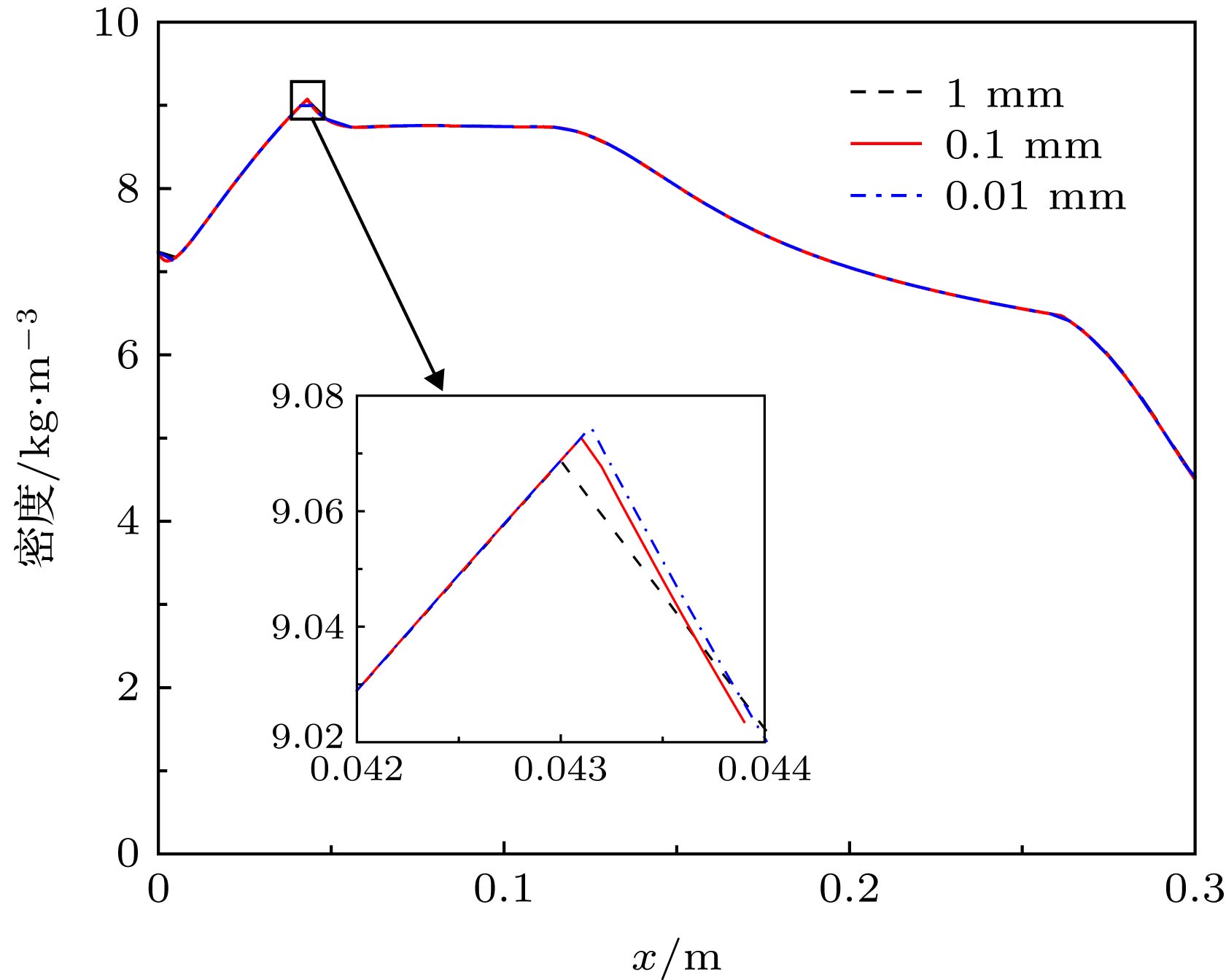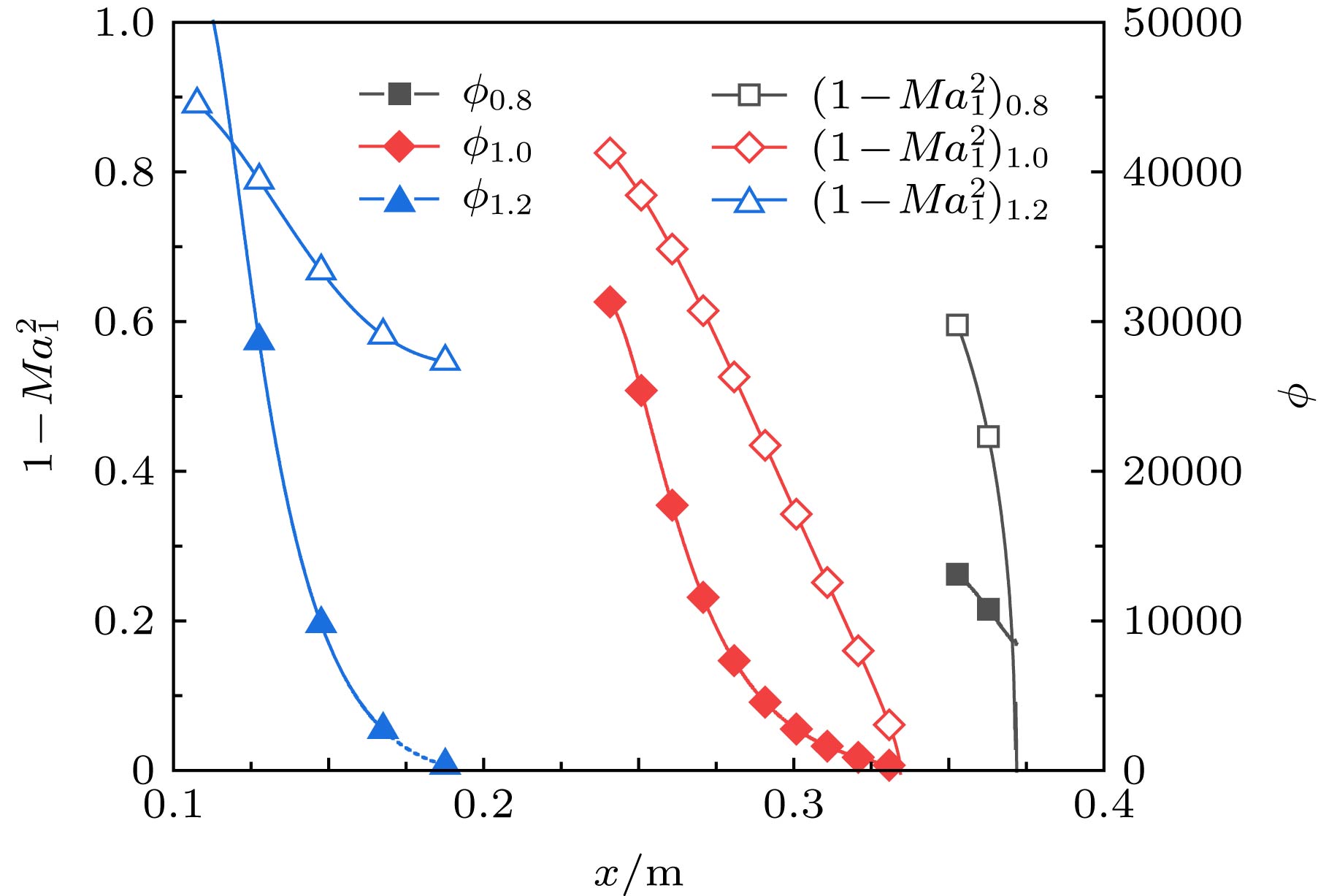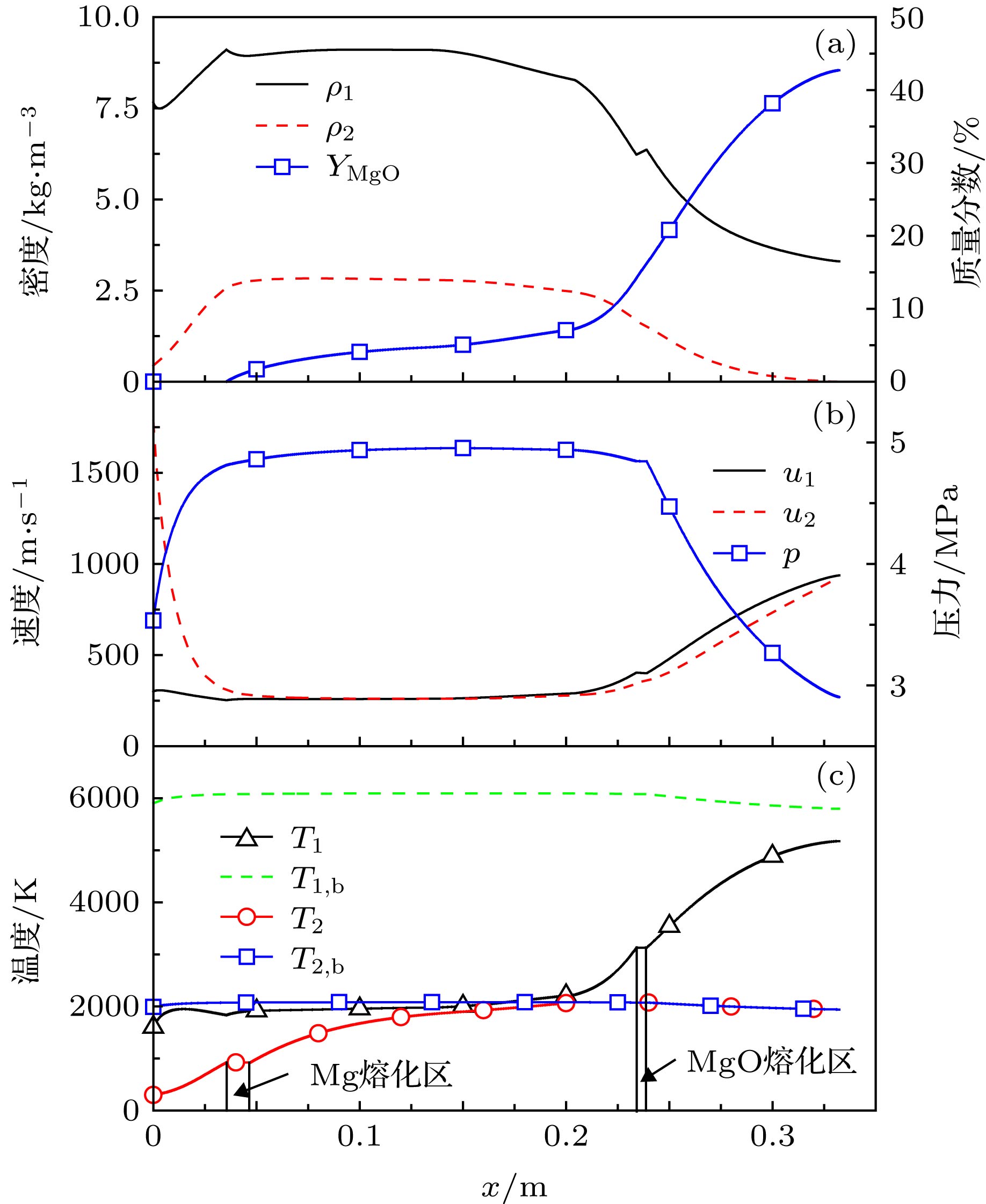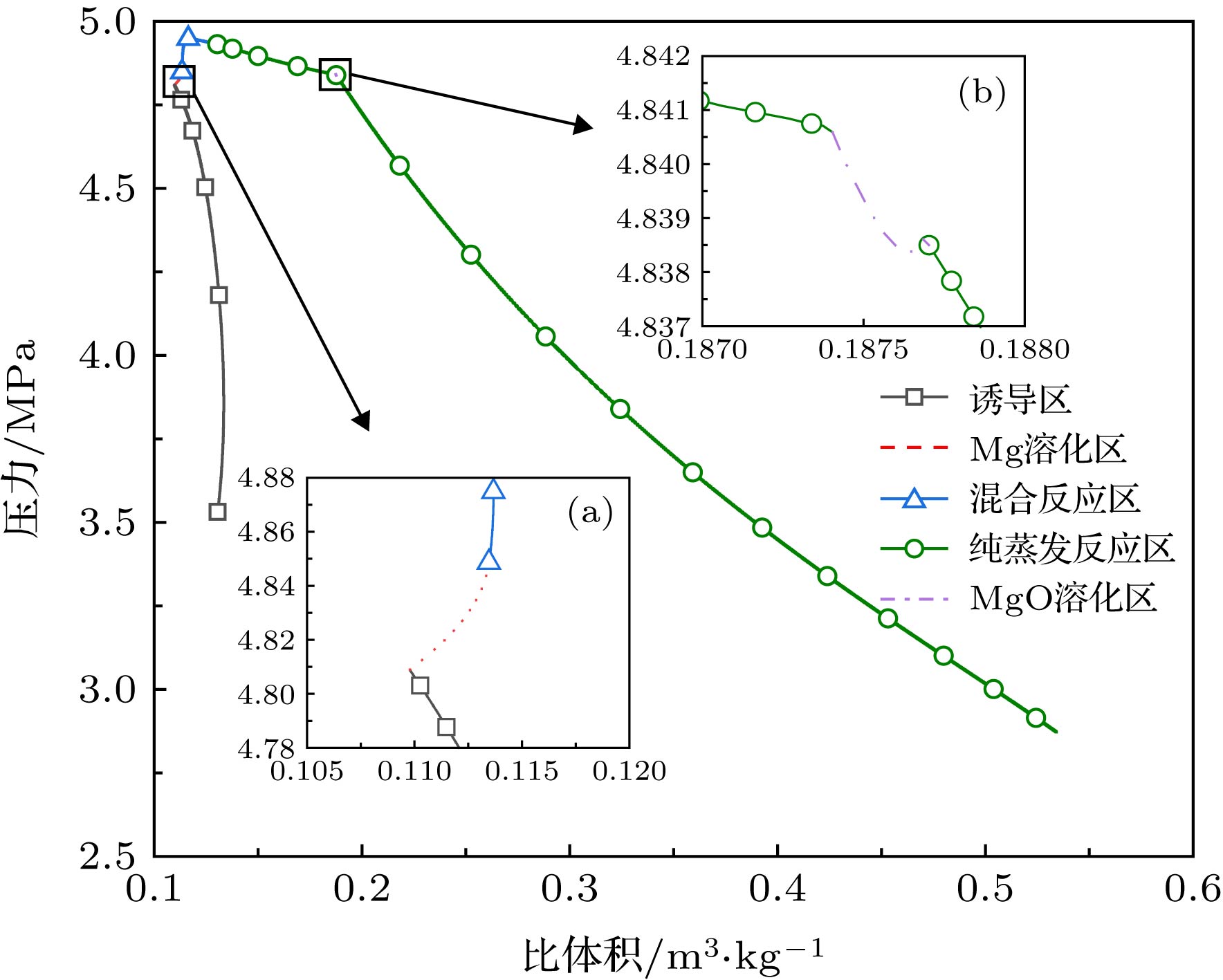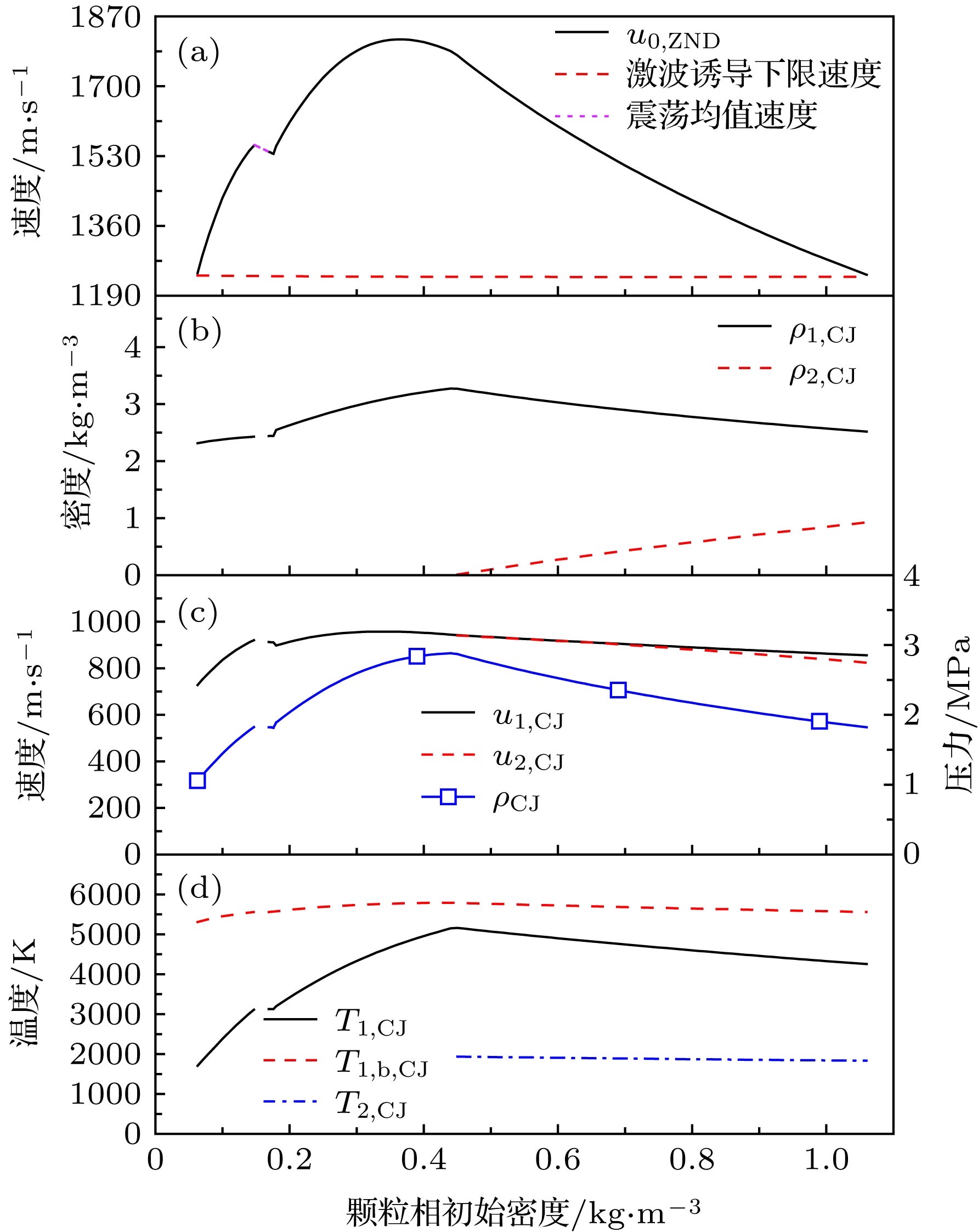-
镁颗粒因其能量密度高、点火特性和燃烧效率好的优势, 作为燃料或添加剂应用于爆震燃烧动力系统具有广阔的应用前景. 本文建立了镁颗粒-空气混合物的一维稳态爆震波模型, 数值模拟爆震波稳态传播过程及其内部流场分布. 结果表明, 镁颗粒-空气混合物爆震波仅能以特征值速度稳定自维持传播, 特征值爆震速度的高低并不仅仅取决于反应放热多少, 两相间的相互作用也会影响热能向气相动能的转化效率. 当爆震波末端氧化镁处于熔化过程时, 满足一定的来流速度和镁颗粒密度条件, 爆震波仍能够稳定自维持传播. 气相吸收反应放热膨胀加速至声速的过程主要发生在镁颗粒纯蒸发反应阶段, 但在氧化镁熔化阶段由于熔化过程吸热量大, 使气相吸热膨胀过程近乎停止. 颗粒粒径变化主要影响爆震波尺寸, 而对特征值爆震速度以及波后声速面参数影响甚微. 在常温常压的初始条件下, 爆震波稳定自维持传播过程中波内不涉及氧化镁的汽化离解过程.
-
关键词:
- 异相爆震 /
- Zeldovich-von Neumann-Döring模型 /
- 镁颗粒燃料
Magnesium particles have broad application prospects as fuel or additive for detonation combustion power systems due to their high energy density, ignition characteristics and combustion efficiency. In this paper, a one-dimensional steady-state model is established for the magnesium particle-air mixture. The distribution of the flow field and the influences of factors such as phase transition process, inlet velocity, particle radius and initial particle density on the structure of detonation wave are analyzed numerically under different working conditions. The studies have shown that the process accelerating to the sound speed due to the expansion of the gas phase mainly occurs in the pure evaporation reaction stage of the magnesium particles. The duration of magnesium and magnesium oxide melting accounts for a small proportion of the entire combustion process. Under the initial conditions of normal temperature and pressure, the theoretical maximum temperature in the detonation wave during self-sustaining propagation is lower than the dissociation temperature of the magnesium oxide. The heat absorbed in the magnesium melting process is released into the gas phase for expansion work as the reaction progresses, leading to a small effect of magnesium melting on the structure of the detonation wave. The amount of exothermic heat absorbed in the magnesium oxide melting process is so large that the process of expansion of the gaseous working fluid is almost stopped. Moreover, the absorbed heat cannot be used for gas phase expansion work. Therefore, the melting process of magnesium oxide has a great influence on the structure of the detonation wave. The detonation wave of the magnesium particle-air mixture can be stabilized and self-sustained only at the eigenvalue velocity. Below this value, a singular point appears in the flow field. Above this value, the wave cannot be accelerated to the speed of sound, and the downstream flow field disturbance can pass through the reaction combustion zone and weaken the intensity of the detonation wave. When the end of the detonation wave is in the melting process, the detonation wave can still stabilize the self-sustaining propagation when a certain inflow velocity and a magnesium particle density are satisfied. Otherwise, the detonation wave can propagate only at an average speed with oscillation. The initial particle concentration corresponding to the peak of the eigenvalue velocity is smaller than the stoichiometric one corresponding to the peaks of the density, pressure and temperature, indicating that the eigenvalue velocity is not dependent solely on the heat release of the reaction because the interaction between the two phases also affects the conversion efficiency of thermal energy into gas phase kinetic energy. Under the premise of uniform distribution of internal temperature of magnesium particles, the particle size mainly affects the size of the detonation wave, but has little effect on the characteristic value of the eigenvalue velocity and the Chapman-Jouguet parameters. The model in this paper comprehensively reflects the influence of the phase transition process in the combustion process on the structure of the detonation wave and the self-sustaining propagation mechanism. It has a certain guiding significance for designing the detonation power device using powder fuel.[1] Wolanski P 2013 Proc. Combust. Inst. 34 125
 Google Scholar
Google Scholar
[2] Veyssiere B, Ingignoli W 2003 Shock Waves 12 291
 Google Scholar
Google Scholar
[3] Veyssiere B, Bozier O, Khasainov B 2002 Shock Waves 12 227
 Google Scholar
Google Scholar
[4] Palaszewski B, Jurns J, Breisacher K, Kearns K 2004 40th AIAA/ASME/SAE/ASEE Joint Propulsion Conference and Exhibit Fort Lauderdale, Florida, USA, July 11−14, 2004 p4191
[5] Bykovskii F A, Zhdan S A, Vedernikov E F, Zholobov Yu A 2010 Dokl. Phys. 55 142
 Google Scholar
Google Scholar
[6] Bykovskii F A, Zhdan S A, Vedernikov E F, Zholobov Yu A 2011 Combust. Expl. Shock Waves 47 473
 Google Scholar
Google Scholar
[7] Bykovskii F A, Zhdan S A, Vedernikov E F, Zholobov Yu A 2012 Combust. Expl. Shock Waves 48 203
 Google Scholar
Google Scholar
[8] Bykovskii F A, Zhdan S A, Vedernikov E F, Zholobov Yu A 2013 Combust. Expl. Shock Waves 49 705
 Google Scholar
Google Scholar
[9] Bykovskii F A, Zhdan S A, Vedernikov E F 2014 Combust. Expl. Shock Waves 50 214
 Google Scholar
Google Scholar
[10] Lee J H S 1998 The Detonation Phenomenon (New York: Cambridge University Press) p7
[11] Fedorov A V, Khmel’ T A, Fomin V M 1999 Shock Waves 9 313
 Google Scholar
Google Scholar
[12] 洪滔 2003 博士学位论文 (北京: 中国工程物理研究院)
Hong T 2003 Ph. D. Dissertation (Beijing: China Academy of Engineering Physics) (in Chinese)
[13] Zhang F 2009 Shock Wave Science and Technology Reference Library (Vol. 4) ( Berlin, Heidelberg: Springer) pp99, 153, 159
[14] Uphoff U, Hänel D, Roth P 1996 Shock Waves 6 17
 Google Scholar
Google Scholar
[15] Fedorov A V, Khmel T A 1999 Combust. Expl. Shock Waves 35 288
 Google Scholar
Google Scholar
[16] Benkiewicz K, Hayashi K 2003 Shock Waves 12 385
 Google Scholar
Google Scholar
[17] 洪滔, 秦承森 2004 爆炸与冲击 24 193
 Google Scholar
Google Scholar
Hong T, Qing C S 2004 Expl. Shock Wave 24 193
 Google Scholar
Google Scholar
[18] Fedorov A V, Khmel’ T A 2005 Combust. Expl. Shock Waves 41 78
 Google Scholar
Google Scholar
[19] Fedorov A V, Khmel’ T A 2005 Combust. Expl. Shock Waves 41 435
 Google Scholar
Google Scholar
[20] Fedorov A V, Khmel’ T A 2008 Combust. Expl. Shock Waves 44 343
 Google Scholar
Google Scholar
[21] 胡洪波, 翁春生 2011 火箭推进 37 47
 Google Scholar
Google Scholar
Hu H B, Wen C S 2011 J. Rocket Propul. 37 47
 Google Scholar
Google Scholar
[22] 韦伟, 翁春生 2012 弹道学报 24 99
 Google Scholar
Google Scholar
Wei W, Wen C S 2012 J. Ball 24 99
 Google Scholar
Google Scholar
[23] 韦伟, 翁春生 2012 南京师范大学学报(工程技术版) 12 53
 Google Scholar
Google Scholar
Wei W, Wen C S 2012 J. Nanjing Normal University (Eng. Technol. Ed.) 12 53
 Google Scholar
Google Scholar
[24] 韦伟, 翁春生 2015 爆炸与冲击 35 29
 Google Scholar
Google Scholar
Wei W, Wen C S 2015 Expl. Shock Wave 35 29
 Google Scholar
Google Scholar
[25] 韦伟, 翁春生 2017 固体火箭技术 40 41
Wei W, Wen C S 2017 J. Solid Rock. Technol. 40 41
[26] 昝文涛, 洪滔, 董贺飞 2017 含能材料 25 508
 Google Scholar
Google Scholar
Zan W T, Hong T, Dong H F 2017 Chin. J. Energ. Mater. 25 508
 Google Scholar
Google Scholar
[27] Teng H, Jiang Z 2013 Combust. Flame 160 463
 Google Scholar
Google Scholar
[28] 杨晋朝, 夏智勋, 胡建新 2012 物理学报 61 164702
 Google Scholar
Google Scholar
Yang J C, Xia Z X, Hu J X 2012 Acta Phys. Sin. 61 164702
 Google Scholar
Google Scholar
[29] 杨晋朝, 夏智勋, 胡建新 2013 物理学报 62 074701
 Google Scholar
Google Scholar
Yang J C, Xia Z X, Hu J X 2013 Acta Phys. Sin. 62 074701
 Google Scholar
Google Scholar
[30] 方丁酉 1988 两相流动力学(长沙: 国防科技大学出版社) 第17页
Fang D J 1988 Two-phase Flow Dynamics (Changsha: National Defense Science and Technology University Press) p17 (in Chinese)
[31] Steinberg T A, Wilson D, Benz F 1992 Combust. Flame 91 200
 Google Scholar
Google Scholar
[32] Kashireninov O E, Kuznetsov V A, Manelis G B 1977 Aiaa J. 15 1035
[33] Gosteev Y A, Fedorov A V 2005 Combust. Expl. Shock Waves 41 190
 Google Scholar
Google Scholar
[34] 洪滔, 秦承森 1999 爆炸与冲击 19 335
 Google Scholar
Google Scholar
Hong T, Qing C S 1999 Expl. Shock Wave 19 335
 Google Scholar
Google Scholar
[35] Zhang F, Murray S B, Gerrard K B 2004 Proceedings of the 24th International Symposium on Shock Waves Beijing, China, July 11−16, 2004 p795
[36] 杨世铭, 陶文铨 2006 传热学 (第4版) (北京:高等教育出版社) 第121页
Yang S M, Tao W Q 2006 Heat Transfer (4th Ed.) (Beijing: Higher Education Press) p121 (in Chinese)
-
图 6 流场参数随颗粒相初始密度的变化 (a) 特征值速度和激波诱导下限速度; (b) 密度; (c) 速度和压力; (d) 温度
Fig. 6. Variation of parameters with different initial concentration of particle phase: (a) Eigenvalue detonation velocity and minimum velocity of particle ignition induced by shock wave; (b) density; (c) velocity and pressure; (d) temperature.
表 1 镁和铝的结果对比
Table 1. Comparison of results of magnesium and aluminum detonation.
燃料种类 质量热值/MJ·kg–1 理论空燃比 爆震波速度/m·s–1 CJ面密度/kg·m–3 CJ面速度/m·s–1 CJ面压力/MPa 镁 25.06 2.87 1782.28 3.27 942.7 2.87 铝 31.07 3.83 1650 2.43 673 2.04 表 2 诱导区及相变区长度
Table 2. Length of induction region and phase-transition region.
总长度 诱导区 燃烧区
(Mg蒸发)Mg
熔化MgO
熔化MgO
离解空间长度/m 0.3324 0.0354 0.297 0.0116 0.0048 × 占比 1 0.106 0.894 0.035 0.014 × 表 3 相变过程对爆震波结构影响对比
Table 3. Effect of phase transition on structure of detonation wave.
$\Delta h_{\rm{Mg},f}$/MJ·kg–1 $\Delta h_{\rm{MgO},f}$/MJ·kg–1 $\eta_{0.99\rm{CJ}}$ 燃烧区占比 0.354 1.946 0.995 0.894 0 1.946 0.952 0.885 0.354 0 0.573 0.872 0 0 0.549 0.865 -
[1] Wolanski P 2013 Proc. Combust. Inst. 34 125
 Google Scholar
Google Scholar
[2] Veyssiere B, Ingignoli W 2003 Shock Waves 12 291
 Google Scholar
Google Scholar
[3] Veyssiere B, Bozier O, Khasainov B 2002 Shock Waves 12 227
 Google Scholar
Google Scholar
[4] Palaszewski B, Jurns J, Breisacher K, Kearns K 2004 40th AIAA/ASME/SAE/ASEE Joint Propulsion Conference and Exhibit Fort Lauderdale, Florida, USA, July 11−14, 2004 p4191
[5] Bykovskii F A, Zhdan S A, Vedernikov E F, Zholobov Yu A 2010 Dokl. Phys. 55 142
 Google Scholar
Google Scholar
[6] Bykovskii F A, Zhdan S A, Vedernikov E F, Zholobov Yu A 2011 Combust. Expl. Shock Waves 47 473
 Google Scholar
Google Scholar
[7] Bykovskii F A, Zhdan S A, Vedernikov E F, Zholobov Yu A 2012 Combust. Expl. Shock Waves 48 203
 Google Scholar
Google Scholar
[8] Bykovskii F A, Zhdan S A, Vedernikov E F, Zholobov Yu A 2013 Combust. Expl. Shock Waves 49 705
 Google Scholar
Google Scholar
[9] Bykovskii F A, Zhdan S A, Vedernikov E F 2014 Combust. Expl. Shock Waves 50 214
 Google Scholar
Google Scholar
[10] Lee J H S 1998 The Detonation Phenomenon (New York: Cambridge University Press) p7
[11] Fedorov A V, Khmel’ T A, Fomin V M 1999 Shock Waves 9 313
 Google Scholar
Google Scholar
[12] 洪滔 2003 博士学位论文 (北京: 中国工程物理研究院)
Hong T 2003 Ph. D. Dissertation (Beijing: China Academy of Engineering Physics) (in Chinese)
[13] Zhang F 2009 Shock Wave Science and Technology Reference Library (Vol. 4) ( Berlin, Heidelberg: Springer) pp99, 153, 159
[14] Uphoff U, Hänel D, Roth P 1996 Shock Waves 6 17
 Google Scholar
Google Scholar
[15] Fedorov A V, Khmel T A 1999 Combust. Expl. Shock Waves 35 288
 Google Scholar
Google Scholar
[16] Benkiewicz K, Hayashi K 2003 Shock Waves 12 385
 Google Scholar
Google Scholar
[17] 洪滔, 秦承森 2004 爆炸与冲击 24 193
 Google Scholar
Google Scholar
Hong T, Qing C S 2004 Expl. Shock Wave 24 193
 Google Scholar
Google Scholar
[18] Fedorov A V, Khmel’ T A 2005 Combust. Expl. Shock Waves 41 78
 Google Scholar
Google Scholar
[19] Fedorov A V, Khmel’ T A 2005 Combust. Expl. Shock Waves 41 435
 Google Scholar
Google Scholar
[20] Fedorov A V, Khmel’ T A 2008 Combust. Expl. Shock Waves 44 343
 Google Scholar
Google Scholar
[21] 胡洪波, 翁春生 2011 火箭推进 37 47
 Google Scholar
Google Scholar
Hu H B, Wen C S 2011 J. Rocket Propul. 37 47
 Google Scholar
Google Scholar
[22] 韦伟, 翁春生 2012 弹道学报 24 99
 Google Scholar
Google Scholar
Wei W, Wen C S 2012 J. Ball 24 99
 Google Scholar
Google Scholar
[23] 韦伟, 翁春生 2012 南京师范大学学报(工程技术版) 12 53
 Google Scholar
Google Scholar
Wei W, Wen C S 2012 J. Nanjing Normal University (Eng. Technol. Ed.) 12 53
 Google Scholar
Google Scholar
[24] 韦伟, 翁春生 2015 爆炸与冲击 35 29
 Google Scholar
Google Scholar
Wei W, Wen C S 2015 Expl. Shock Wave 35 29
 Google Scholar
Google Scholar
[25] 韦伟, 翁春生 2017 固体火箭技术 40 41
Wei W, Wen C S 2017 J. Solid Rock. Technol. 40 41
[26] 昝文涛, 洪滔, 董贺飞 2017 含能材料 25 508
 Google Scholar
Google Scholar
Zan W T, Hong T, Dong H F 2017 Chin. J. Energ. Mater. 25 508
 Google Scholar
Google Scholar
[27] Teng H, Jiang Z 2013 Combust. Flame 160 463
 Google Scholar
Google Scholar
[28] 杨晋朝, 夏智勋, 胡建新 2012 物理学报 61 164702
 Google Scholar
Google Scholar
Yang J C, Xia Z X, Hu J X 2012 Acta Phys. Sin. 61 164702
 Google Scholar
Google Scholar
[29] 杨晋朝, 夏智勋, 胡建新 2013 物理学报 62 074701
 Google Scholar
Google Scholar
Yang J C, Xia Z X, Hu J X 2013 Acta Phys. Sin. 62 074701
 Google Scholar
Google Scholar
[30] 方丁酉 1988 两相流动力学(长沙: 国防科技大学出版社) 第17页
Fang D J 1988 Two-phase Flow Dynamics (Changsha: National Defense Science and Technology University Press) p17 (in Chinese)
[31] Steinberg T A, Wilson D, Benz F 1992 Combust. Flame 91 200
 Google Scholar
Google Scholar
[32] Kashireninov O E, Kuznetsov V A, Manelis G B 1977 Aiaa J. 15 1035
[33] Gosteev Y A, Fedorov A V 2005 Combust. Expl. Shock Waves 41 190
 Google Scholar
Google Scholar
[34] 洪滔, 秦承森 1999 爆炸与冲击 19 335
 Google Scholar
Google Scholar
Hong T, Qing C S 1999 Expl. Shock Wave 19 335
 Google Scholar
Google Scholar
[35] Zhang F, Murray S B, Gerrard K B 2004 Proceedings of the 24th International Symposium on Shock Waves Beijing, China, July 11−16, 2004 p795
[36] 杨世铭, 陶文铨 2006 传热学 (第4版) (北京:高等教育出版社) 第121页
Yang S M, Tao W Q 2006 Heat Transfer (4th Ed.) (Beijing: Higher Education Press) p121 (in Chinese)
计量
- 文章访问数: 9591
- PDF下载量: 95
- 被引次数: 0














 下载:
下载:
